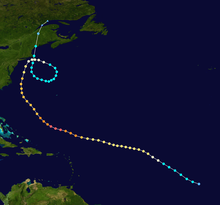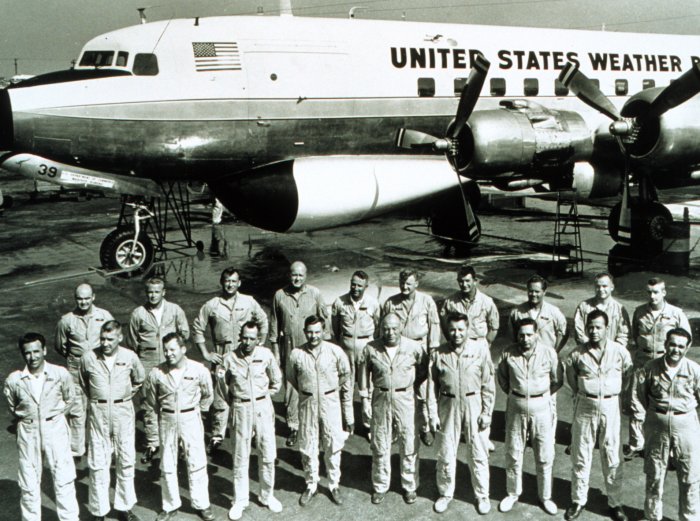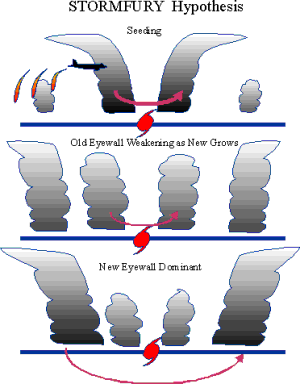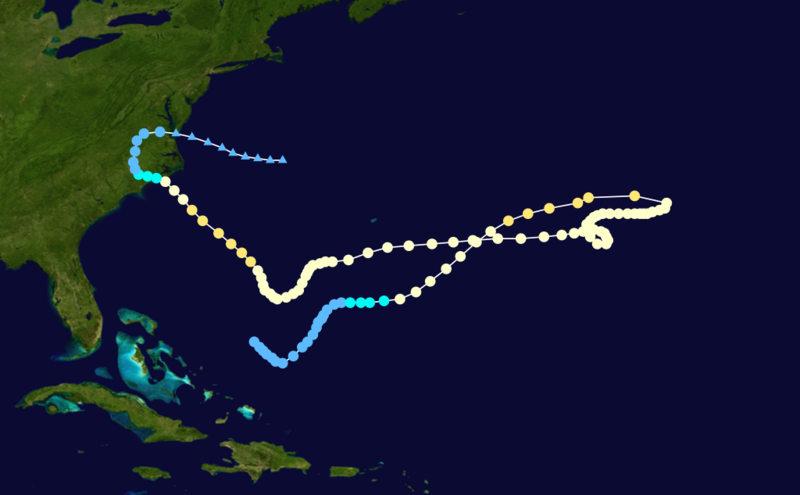While I am working on a post about the 2018 minimum, I am not all that interested in the subject, as the “Death Spiral” was disproved several years ago, and this year just does it again. To prove the same thing over and over is about as exciting as catching a fish, letting out line and allowing the fish swim away still securely hooked, and then catching the same fish again.
The only reason people get caught up in proving the same thing over and over is because the “Death Spiral” crowd insist on proving the wrong thing over and over again. I suspect that, for some, politics is involved and it is their version of telling “The Big Lie.” However in terms of scientific discover it is yawningly dull. I’d far prefer to move on to fresh discovery.
I started thinking about sooting sea-ice not because the Death Spiral Crowd talks about controlling sea-ice by buying curly light bulbs, but rather because Joe Bastardi was talking about seeding hurricanes. He was venturing that it might be possible to destabilize storms by weakening a section of the eyewall.
Joe has carefully examined every hurricane and typhoon he’s been able to, since he first became fascinated as a boy over fifty years ago, and his study has poured through history books to study storms before he was born, and he has noticed things have to be perfect to keep a hurricane mighty, and sometimes small things can cause a storm to lose its punch. For example, Hurricane Katrina, though mighty, decreased from a Cat 5 to a Cat 3 storm as it approached land. Though awful, it could have been worse. Joe’s knowledge has been proven by his ability to foresee the strengthening and weakening of storms. He is mulling over how we might lessen damage by seeding storms as they approached land.
This idea is not new. Men flew into storms to test the idea of weakening them by seeding clouds back in 1947. It was called “Project Cirrus”. A hurricane was chosen that appeared to be headed out to sea, but it began a turn even as planes flew out to seed it, and after being seeded, it continued to turn and headed straight for Savannah, and clobbered Georgia. Lawyer’s eyes lit up, there was all sorts of litigation, and meteorologists decided maybe they wouldn’t continue with the experiments.
However the idea wouldn’t die, and Hurricane Esther was seeded in 1961. Some were worried because Esther performed a remarkable loop. However it did weaken.
From the “success” of seeding Esther was born “Project Stormfury”. Here’s a picture of the crew in 1966:

The first hurricane Stormfury seeded was Beulah in 1963. The first days flights missed their targets, and the second day’s flight hit them. They looked to see if the expected results occurred.

Beulah’s inner eyewall fell apart and a larger eyewall formed, and it’s winds slowed by 20%. You can see why the fellows were encouraged. But was it man-caused, or was it what we now call natural “eyewall replacement”? They didn’t know about eyewall replacement back then. They were actually gathering data that both proved their theory and led to their theory’s demise.
They cancelled the seeding of Betsy in 1965 but forgot to tell the media, which reported the storm had been seeded. There was an uproar when Betsy smashed into Florida, and congress very nearly cut off their funding.
The final storm seeded was Ginger in 1971. I don’t know when it was seeded, but suspect they were blamed for the storms zany track, even if they seeded it after it performed its looping and backtracking.

They continued to exist as an entity for a decade longer, but did most of their study in their minds, marveling at the increasingly wonderful pictures made available by the swiftly improving satellites. But it doesn’t matter what you do, some people are bound to be suspicious. A “Chemtrails” crowd existed even back then, and Fidel Castro insisted that Stormfury was an attempt to “weaponize” hurricanes. A plan to move the project to the Pacific was torpedoed by outcries from both China and Japan. Maintaining the airplanes was expensive, and Stormfury eventually died a quiet death due to Reagan’s push for budget cuts and also because the researchers themselves were becoming aware that eyewall replacement could be normal and natural, and not due to seeding.
Two things become apparent looking at Stormfury. First, that scientists can take a hard look at data and disprove their own theories. Second, that people who know next to nothing about the data can raise an almighty fuss even when you don’t do anything (as was the case with Betsy.)
Suppose I leaked out that I’d sent a fireworks rocket I made at home and it exploded confetti in the middle of Hurricane Florence a couple of weeks ago, and claimed my confetti had diminished the storm from a Cat 4 to a Cat 1 at landfall. Rather than any praise I can bet you a hundred lawyers would now be knocking at my door, half to sue me for flooding in North Carolina, and half to sue me because Florence unexpectedly turned south into South Carolina. And not a single one of them would know a thing about hurricanes.
I far prefer the studious attitude of Joe Bastardi. He watched Florence with a fierce concentration, bringing fifty years of knowledge to bear but also displaying the obvious delight and wonder of a child when he saw something he had not noticed before. He is not too old to be constantly learning.
That is science as science should be. Before seeding a hurricane there should be concentration on what is to be expected, and awareness there may be unexpected consequences. (There will be the usual outcry from tree-huggers, who complain shooting polar bears is evil, until the bear is looking in the window of their child’s daycare.) Only after a careful assessment, involving much input, should the experiment be undertaken. Then their should be careful observations of what occurs, and a follow-up assessment of results.
This is not the case in much of the fuss about sea-ice. Largely for political reasons an amazing amount of money has been poured into research about sea-ice, and we know far more than we did, and things the equivalent to “eyewall replacement” are becoming evident, but the “Death Spiral” crowd stubbornly refuse to see anything but a Death Spiral. It would be as if the Stormfury scientists refused to see that anything, besides their seeding, could influence a hurricane’s eyewall.
For example, we are now far more aware the sea-ice has greater mobility than some initially assumed, and at times is far more mobile than other times when it is far more static. Rather than any sort of focus on how such fluctuation might effect sea extent levels (and therefore effect albedo and other effects, which would have further effects), the Death Spiral crowd claims CO2 is the culprit. That’s their story and they are sticking to it, as stubborn as mules.
This is especially exasperating when they refuse to use the resources provided by history. Where Joe Bastardi is always eager to read about what hurricanes did before he was born, the Death Spiral crowd seem determined to “erase the Medieval Warm Period”, and anything else that disagrees with what their model was programed to produce, which is basically that the Arctic Sea was wall-to-wall ice until just recently.
This is tantamount to a willful blindness, a refusal to see that which is marvelous and wonderful, that which can teach us much about how sea-ice behaves, and that which can teach us whether we would benefit by covering a large amount of the ice with black soot.
I’ll end with a comment I posted at WUWT. We were wondering if icebreakers might influence how able the sea-ice is to be flushed out of the arctic, or be melted in other ways, but I like my comment because it also describes how wrong scientific opinion can be, and how actual observation can correct errors:
“As an example (of how sea-ice can be relatively static and then very mobile) I’d like to point out the history of the good ship Jeanette, which set out for the North Pole from San Francisco in 1879. They were buoyed by three false hopes.
1.) They believed the North Pole could not be covered by ice, because salt water behaves differently than fresh water. The coldest fresh water rises, and therefore the surface of ponds freeze, but the addition of salt causes the coldest salt water to sink. This is scientific fact. Therefore the waters of the Arctic Sea could never freeze, (unless from the bottom up) for such waters would sink as they cooled, and be replaced by warmer waters rising from below.
2.) Sea ice was tested and found to be fresh water. Therefore it could not originate from salt water, and must be due to inflows of fresh water from rivers along arctic coasts. Therefore all sea-ice would be concentrated along arctic coasts, and if you could penetrate that sea-ice you’d find open water off shore
3.) Some whalers had reported landing on Wrangel Island with a lot of open water around, and therefore it seemed Wrangel Island might be a doorway to the open seas beyond.
Wrong. The Jennette was trapped by sea ice short of Wrangle Island, near Herald Island. The sea-ice had increased since the whalers found open seas, and during the following 21 months the sea-ice erratically took them barely a degree longitude per month to the west. (During this time an icebreaker would have been handy).
But then the sea-ice situation changed radically. The ice began to shift, and the Jeannette was crushed. The 33 members of the crew headed southwest, making it to the New Siberian Islands on ice, but facing open water as they headed to the swamps of the Lena Delta. (Only 13 made it out alive.)
Meanwhile two ships following behind, looking for the lost Jeannette, did not find the Jeannette because they (including the Naturalist John Muir) were able to land upon both Herald Island and Wrangel Island and dilly-dally about surveying both islands. They failed to find the Jeannette but found lots of open water, because the sea-ice was in motion, and moving far faster than it had formally moved.
We know how fast the sea-ice moved, because the crushed Jeannette didn’t sink (though parts of it likely sunk, being iron,) and instead moved, in the next 36 months, more than halfway around the earth, in terms of longitude. The sea-ice the crushed beams and planks were squeezed by moved west along the entire north coasts of Russia and Scandinavia, likely north of Svalbard, and took a left through Fram Strait and then down the entire east coast of Greenland, and then took a sharp right around Cape Farewell and were found nearly three years to the day of when the ship was abandoned, in Baffin Bay off Julianehåb. Miles? You figure it out for me, but the ship was abandoned at 77° 15′ north and 154°59′ east, and the wreckage was found at around 60° 70′ north and 46° 05′ WEST.
Yowza.
This incredible movement of sea-ice in 36 months is what gave Nansen the idea he could park the Fram in Sea Ice in East Siberia and drift across the Pole.
But me? I lack Nansen’s ambition. Instead I sit back and say, “Yowza!” I see that, once sea-ice takes it into its head to move, tremendous forces are involved, and the entire fleet of Russian icebreakers can’t matter much more than fifteen mice standing before an avalanche with stop signs.
And if the mighty Russian ships matter so little before such power, how stupid it is for silly people to think buying curly light bulbs and all other forms of virtue-signaling will have the slightest effect?
Not that we shouldn’t consider ways we might deflect disasters when they are apparent. We should consider spreading black soot on sea-ice the same way we consider seeding hurricanes. However such actions involve at least a basic understanding of the forces we are attempting to influence.
Sad to say, politics has utterly polluted the understanding of many, concerning sea-ice. Unless and until we remove this rot, the subject of sea-ice cannot even reach the level of a basic understanding. Politics is like taking a stupid-pill. It might be screamingly obvious that all mankind would benefit if we spread soot and reduced sea-ice, but political correctness would shout more ice was better.”
